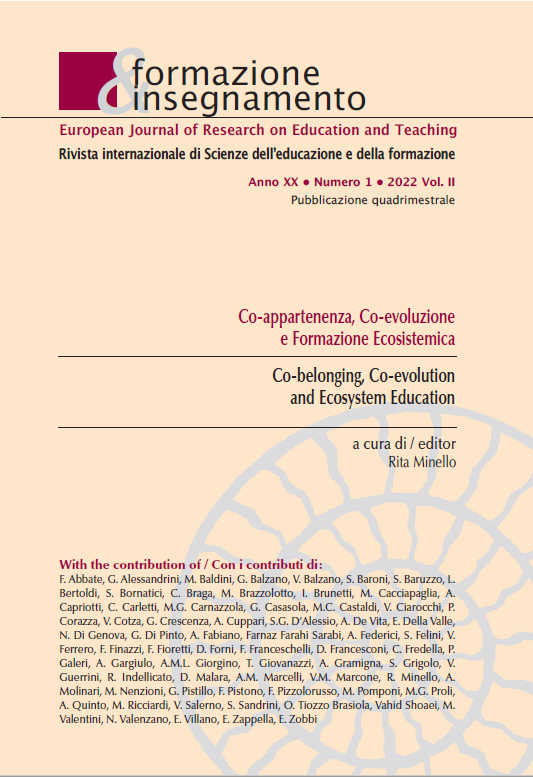Visual System and Posture: Influences on Developmental Dyslexia - Systematic Review
DOI:
https://doi.org/10.7346/-fei-XX-01-22_83Keywords:
Vision, Posture, Dyslexia, Primary school, Motor activityAbstract
The great increase of diagnoses of developmental dyslexia has been the purpose of this review. Its goal is to evaluate scientific studies which research the influence of sight and posture on developmental dyslexia; considering its neurobiological bases, therefore focusing on the systems involved, such as cerebellar, somatosensory, vestibular, and visual system. Interest has been given to both components which are movement and sight, focusing on experiments realized in Primary School. Therefore, it can be useful also for Preschool teachers to mature more awareness about the importance of promoting motor activity, a correct posture and avoid visual tiredness during the didactics, in order to prevent learning disorders.
References
Barela, J.A., Tesima, N., Amaral, V.D.S., Figueiredo, G.A., Barela, A.M.F. (2020). Visually guided eye movements reduce postural sway in dyslexic children. Neuroscience Letters, 725, 134890.
Bucci, M. P., Mélithe, D., Ajrezo, L., Bui-Quoc, E., & Gérard, C. L. (2014). The influence of oculomotor tasks on postural control in dyslexic children. Frontiers in human neuroscience, 8, 981.
Bucci, M.P., Gerard, C.L., Bui-Quoc, E. (2013). The effect of a cognitive task on the postural control of dyslexic children. Research in developmental disabilities, 34(11), 3727–35.
Bucci, M.P., Goulème, N., Dehouck, D., Stordeur, C., Acquaviva, E., Septier, M., Lefebvre, A., Gerard, C.L., Peyre, H., Delorme, R. (2018). Interactions between eye movements and posture in children with neurodevelopmental disorders. International Journal of Developmental Neuroscience, 71(1), 61-67.
Byl, N. N., Byl, F. M., Rosenthal, J. H. (1989). Interaction of spatial perception, vestibular function, and exercise in young school age boys with learning disabilities. Perceptual and Motor Skills, 68, 727–738.
Caldani, S., Gerard, C.L., Peyre, H., Bucci, M.P. (2020). Visual attentional training improves reading capabilities in children with dyslexia: an eye tracker study during a reading task. Brain sciences, 10(8), 558.
Da Cunha, H.M., Da Silva, O.A. (1986). Postural deficiency syndrome. Its importance in ophtalmology. Journal francais d’ophtalmologie, 9(11), 747-55.
Farmer, M.E., Klein, R.M. (1995). The evidence for a temporal processing deficit linked to dyslexia: a review. Psychonomic bulletin & review, 2(4), 460–493.
Giovagnoli, S. (2009). Percezione Visiva e Dislessia Evolutiva, [Dissertation thesis], Alma Mater Studiorum Università di Bologna. Tesi di Dottorato di ricerca in Psicologia generale e clinica, 21 Ciclo. DOI 10.6092/unibo/amsdottorato/1517.
Goulème, N., Delorm, R., Villeneuve, P., Gérard, C.L., Peyre, H., Bucci, M.P. (2019). Impact of somatosensory input deficiency on subjective visual vertical perception in children with reading disorders. Frontiers in neurology, 10, 1044.
Goulème, N., Gerard, C.L., Bucci, M.P. (2015). The effect of Training on Postural Control in Dyslexic Children. Plos ONE, 10(7), e0130196.
Gouleme, N., Gerard, C.L., Bui-Quoc, E., Bucci, M.P. (2014). Spatial and temporal analysis of postural control in dyslexic children. Clinical neurophysiology: official journal of the International Federation of Clinical Neurophysiology, 126(7), 1370–1377.
Goulème, N., Villeneuve, P., Gérard, C.L., Bucci, M.P. (2017). Influence of both cutaneous input from the foot soles and visual information on the control of postural stability in dyslexic children. Gait & posture, 56, 141–146.
Legrand, A., Bui-Quoc, E., Doré-Mazars, K., Lemoine, C., Gérard, C. L., & Bucci, M. P. (2012). Effect of a dual task on postural control in dyslexic children. PloS ONE, 7(4), e35301.
Levinson, H. (1988). The cerebellar-vestibular basis of learning disabilities in children, adolescents and adults: hypothesis and study. Perceptual and motor skills, 67(3), 983–1006.
Lovegrove, W., Martin, F., Slaghuis, W. (1986). A theoretical and experimental case for a visual deficit in specific reading disability. Cognitive Neuropsychology, 3(2), 225-67.
Lukasova, K., Silva, I.P., Macedo, E.C. (2016). Impaired oculomotor behaviour of children with developmental dyslexia in antisaccades and predictive saccades tasks. Frontiers in psychology, 7, 987.
Lyon, G.R., Shaywitz, S.E, Shaywitz, B.A. (2003). A Definition of Dyslexia. Annals of Dyslexia, 53(1), 1-14.
Moe-Nilssen, R., Helbostad, J.L, Talcott, J.B., Toennessen, F.E. (2003). Balance and gait in children with dyslexia. Experimental brain research, 150(2), 237–244.
Pozzo, T., Vernet, P., Creuzot-Garcher, C., Robichon, F., Bron, A., Quercia, P. (2006). Static postural control in children with developmental dyslexia. Neuroscience Letters, 403(3), 211–215.
Razuk, M., Barela J.A. (2014). Dyslexic children suffer from less informative visual cues to control posture. Research in developmental disabilities, 35(9) 1988-1944.
Razuk, M., Barela, J.A., Peyre, H., Gerard, C.L., Bucci, M.P. (2018). Eye movement and postural sway in dyslexic children during sitting and standing. Neuroscience Letters, 686, 53-58.
Slaghuis, W.L., Lovegrove, W.J., Davidson, J.A. (1993). Visual and language processing deficits are concurrent in dyslexia. Cortex; a Journal Devoted to the Study of the Nervous System and Behavior, 29, 601-15.
Stoodley, C. J., Fawcett, A. J., Nicolson, R. I., & Stein, J. F. (2005). Impaired balancing ability in dyslexic children. Experimental brain research, 167(3), 370–380.
Vidyasagar, T. R., & Pammer, K. (2010). Dyslexia: a deficit in visuo-spatial attention, not in phonological processing. Trends in cognitive sciences, 14(2), 57–63.
Vieira, S., Quercia, P., Michel, C., Pozzo, T., Bonnetblanc, F. (2009). Cognitive demands impair postural control in developmental dyslexia: a negative effect that can be compensated. Neuroscience Letters, 462(2), 125–129.
Downloads
Published
How to Cite
Issue
Section
License
Copyright (c) 2022 Manuela Valentini, Sara Felini

This work is licensed under a Creative Commons Attribution 4.0 International License.
Formazione & insegnamento is distributed under Attribution 4.0 International (CC BY 4.0).
For further details, please refer to our Repository & Archiving Policy, as well as our Copyright & Licensing Terms.





